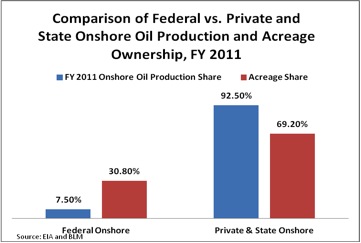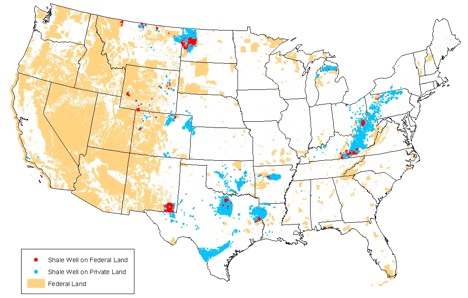Using a study by the Energy Information Administration[i], we have shown that offshore oil production on Federal lands declined by 17 percent in fiscal year 2011 from fiscal 2010 levels. The much reduced production was principally due to the moratorium and de facto moratorium placed on offshore drilling by the Obama Administration after the oil spill accident in the Gulf of Mexico in April 2010. This post will investigate Federal onshore oil production in comparison to oil production on private and state lands.
A recent Congressional Research Service (CRS) report on Federal and Non-Federal Oil Production found that oil production from the federal onshore mineral estate was a mere 306,000 barrels per day (5.5 percent) out of a total of 5,590,000 barrels produced daily from all sources in the United States in fiscal year 2011.[ii] Using the CRS report and EIA production data, total onshore oil production on private, state and federal lands is 4,068,273 barrels per day in fiscal year 2011 (73 percent of total U.S. oil production). The Federal component of onshore oil production is just 7.5 percent of the total oil produced from all U.S. onshore properties in fiscal year 2011. That means that 92.5 percent of the oil produced onshore in the United States is on private and state lands.
The federal government owns 699,700,000 acres of the U.S. “mineral estate,” –where energy is found — out of a total acreage of 2,271,343,360. That means the United States owns 30.8 percent of the lands that could be explored for oil production in the United States, but produced only 7.5 percent of the total oil produced onshore in the United States in fiscal year 2011, or 0.1596 barrels per acre. That compares to 0.87375 barrels of oil per acre produced on all non-federal mineral estate lands. The latter number is most likely a low estimate of oil production per acre on private and state lands because not all lands hold mineral resources. But using the above numbers, per acre, 5.5 times more oil is produced on private and state lands than on federal lands.
One of the fastest growing sources of oil and natural gas is in shale formations where energy is produced using hydraulic fracturing and horizontal drilling. In hydraulic fracturing water and chemicals are pumped into the well to break up the shale rock so that horizontal drilling can be used to obtain the oil or natural gas from the well. The Bakken shale formation in North Dakota and the Eagle Ford shale formation in Texas are two shale formations producing vast amounts of oil in those states. The map below depicts shale wells on private and state lands versus federal lands. The large disparity between the amount of shale oil production on state and private lands versus federal lands can be seen from the wells on this map.
Shale Wells on Private and State Lands Versus Federal Lands
Source: PFC Energy North America Onshore Service
[i] Energy Information Administration, Sales of Fossil Fuels Produced from Federal and Indian Lands, FY 2003 through FY 2011, March 14, 2012, http://www.eia.gov/analysis/requests/federallands/pdf/eia-federallandsales.pdf
[ii] Congressional Research Service, U.S. Crude Oil Production in Federal and Non-Federal Areas, March 20, 2012, http://freebeacon.com/wp-content/uploads/2012/03/R42432.pdf
http://www.blm.gov/public_land_statistics/pls98/98PL1-3.PDF





